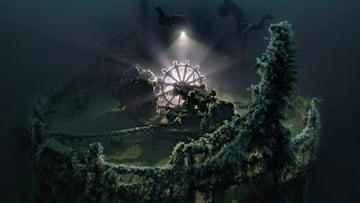What are the deepest known shipwrecks in history?
The Titanic may be the most famous shipwreck but resting at around 12,500 feet below the sea it is far from the deepest sunken vessel to litter the seabed.

The Titanic may be the most famous shipwreck since the “unsinkable” vessel met its terrible fate during its maiden voyage on a calm chilling night in April 1912. Less than three hours of striking an iceberg, the behemoth of its day slipped beneath the surface never to rise again.
The seabed is littered with dozens of ships that have been sunk throughout history. The most famous is the Titanic, but it is far from being the only well-known one. Among the most prominent we find the deepest wreck ever identified: a destroyer escort of the United States Navy which sank during World War II, called the USS Samuel B. Roberts. It was lost to the sea in the year 1944.
US vs Japan
It sank during the Battle of Samar in the Philippine Sea, and was found at a depth of 22,621 feet (6,895 meters), according to the BBC. The ship became famous for its heroic resistance to Japanese troops. Its history, however, was brief: barely a year passed between its being put out to sea for the first time on December 6, 1943, until its subsequent sinking at the end of the following year. Despite this, it earned a Battle Star and a Presidential Citation for the “extraordinary act of heroism” of its crew.
Despite being outnumbered and outgunned by the enemy army, the ship managed to contain and defend itself against several Japanese ships before its fatal outcome. Of the 224 crew members on board, 89 went down with it in the Philippine Sea. Another 120 clung to lifeboats and waited for nearly 50 hours to be rescued.

READ ALSO: The reason Suleman Dawood accompanied his father on the Titan submarine
Discovered on a private dive
The wreck’s discovery was the work of billionaire and adventurer Victor Vescovo, owner of a deep-immersion submersible. Vescovo, a Navy reservist in his day, considered it an honor to have found this ship that was lost nearly 80 years ago.
“It was an extraordinary honor to locate this incredibly famous ship and, in doing so, to have the opportunity to retell her story of heroism and duty to those who may not know of the ship and the sacrifice of her crew,” he told BBC.
The expert said that “steel doesn’t lie and that the wrecks of these vessels are the last witnesses to the battles that they fought.” As he explains, the Sammy B fought Japanese heavy cruisers “at point blank range”, firing so fast that she ran out of ammunition.
“It was down to shooting smoke shells and illumination rounds just to try to set fires on the Japanese ships, and it kept firing. It was just an extraordinary act of heroism. Those men - on both sides - were fighting to the death.”
READ ALSO: Paul-Henri Nargeolet, beloved deep-sea explorer
Missile holes is the wreckage of the ship
In the images captured by the adventurer’s submarine, the Limiting, you can see the structure of the hull, the cannons and the torpedo tubes used to shoot. The Samuel B. Roberts currently has holes as a result of Japanese shells, as well as a major impact in the stern area (rear of the ship). As it has been found, everything indicates that the bow (front part) was the first to hit the seabed.
Much of the ocean floor is less than 20,000 feet (6,000 meters) deep, which made the discovery of this important ship sunk decades ago even more relevant. But this is not the first discovery by Vescovo, who last year found the wreckage of the destroyer USS Johnston at a depth of 21,200 feet (6,460 meters). His team says there are other ships that have not yet been found.
“The USS Gambier Bay (escort carrier) and the USS Hoel (destroyer)”, said Kelvin Murray of EYOS, the company that led the expedition. “We’ve got historical records relating to where they may have sunk. We did take a look for the Gambier Bay, but this is detective work and these kinds of deep-ocean operations have never been conducted before.”
READ ALSO: When Rojas visited the Titanic shipwreck
Other deep shipwrecks
Found in shallower waters are the SS Río Grande (1944) at 19,000 feet (5,760 meters), the USS Indianapolis (1945) at 18,000 feet (5,500 meters), the USS America (2005) at 16,800 feet (5,140 meters), the Soviet submarine K-129 (1968) at 16,000 feet (4,900 meters, and the KMS Bismarck (1941) at 15,000 feet (4,790 meters), among others.
Famous shallow wrecks
However, not all famous wrecks can be found in the deep- some of them can easily reached by free divers.
On the opposite end of the depth spectrum we find the SS Winfield Scott (1853)- a side wheel steamboat that transported passengers and cargo between San Francisco, California and Panama- at 29 feet (eight meters); the Mary Rose (1545)- flagship warship of the British monarch Henry VIII at 40 feet (12 meters); and the Ray of Hope (2003) -ship about 200 feet long (60 meters) at 40-60 feet (15 meters).





